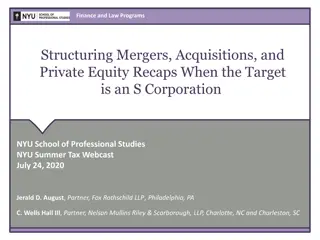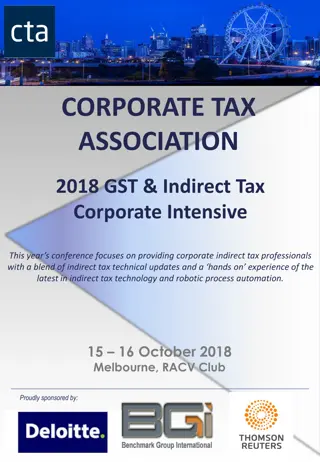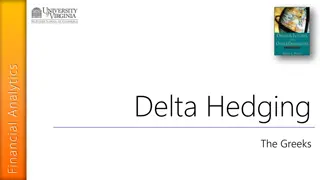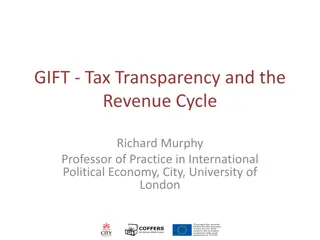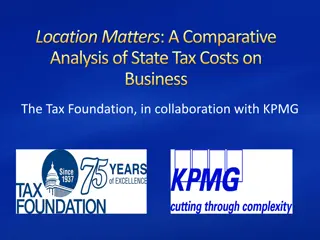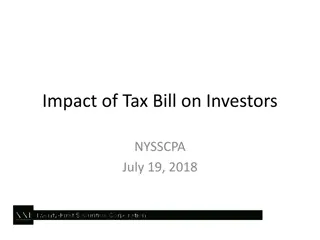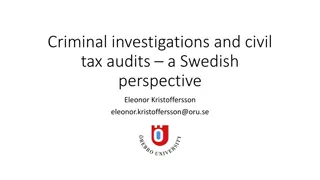Tax Strategies for Corporate Acquisitions - Hedging FX Purchase Price of Target
Explore the intricacies of hedging foreign exchange purchase prices in corporate acquisitions, including forward contracts, integration rules, and IRS-initiated adjustments. The presentation delves into potential consequences, key requirements for taxpayers, and regulatory considerations. Gain insights into managing currency fluctuations effectively during acquisitions.
Download Presentation

Please find below an Image/Link to download the presentation.
The content on the website is provided AS IS for your information and personal use only. It may not be sold, licensed, or shared on other websites without obtaining consent from the author.If you encounter any issues during the download, it is possible that the publisher has removed the file from their server.
You are allowed to download the files provided on this website for personal or commercial use, subject to the condition that they are used lawfully. All files are the property of their respective owners.
The content on the website is provided AS IS for your information and personal use only. It may not be sold, licensed, or shared on other websites without obtaining consent from the author.
E N D
Presentation Transcript
Practising Law Institute Tax Strategies for Corporate Acquisitions 2014 Financial Products and Transactions December 5, 2014 Viva Hammer Joint Committee on Taxation Andrea Hoffenson IRS Associate Chief Counsel (Financial Institutions & Products, Branch 2) Erika W. Nijenhuis, Cleary Gottlieb Steen & Hamilton LLP Matthew A. Stevens Ernst & Young LLP These slides were not prepared by Ms. Hoffenson or Ms. Hammer, and do not represent any official government position.
Agenda Update from the Hill Hedging FX purchase price of target Modifying exchangeable bonds to permit spin (PLR 201431003) REIT spin and conversion-related guidance 1
Hedging FX purchase price of Target Facts: US Corp agrees to acquire foreign target in 3 months for fixed amount of foreign currency. To hedge its exposure to currency fluctuations during that time, US Corp executes forward contract. Contract to acquire UK Target in 3 months for fixed amount of GBP US Corp 3rd Party GBP/USD forward contract US Corp to acquire GBP (the purchase price of Target) in 3 months for fixed amount of USD UK target 3rd Party Dealer 4
Hedging FX purchase price of Target If no integration under Treas. Reg. 1.988-5(b), gain or loss on the forward generally recognized currently, but straddle rules may defer losses. If integration, gain or loss reduces or increases basis of the stock of target. Key requirements for taxpayer-initiated integration: timely identification of hedge and hedged item hedge/forward and the hedged item (the purchase) must be in the same legal entity parties to the hedge cannot be related (compare Treas. Reg. 1.1275- 6(c)(1)(ii)). 5
Hedging FX purchase price of Target IRS-initiated integration under the regulations. Treas. Reg. 1.988-5(b)(3)(ii): If a taxpayer enters into an executory contract and a hedge but fails to satisfy one or more of the requirements of paragraph (b) of this section and, based on the facts and circumstances, the Commissioner concludes that the executory contract in substance is hedged, then the Commissioner may apply the [integration rules] as if the taxpayer had satisfied all of the requirements therein, and may make appropriate adjustments. The Commissioner may apply the integration rules regardless of whether the executory contract and the hedge are held by the same taxpayer. Under what circumstances does the IRS do this? Potentially unpleasant consequences when acquisition vehicle is a CFC. 6
Modifying exchangeable bonds to permit spin (PLR 201431003) 7
Modifying exchangeable bond prior to spin (PLR 201431003) Simplified Facts (with hypothetical numbers added for illustration): USCorp previously issued $1,000 exchangeable bond (publicly traded). Bond is treated as contingent payment debt instrument (CPDI). Assume: 10 year bond, with zero coupons (all payments at maturity). 10% comparable yield, and a single projected payment of $2,593 at maturity. At the end of year 7, AIP = $1,948, but FMV = $1,000 (or less) 8
Modifying exchangeable bond prior to spin (PLR 201431003) USCorp is contemplating a spin-off of a subsidiary. BUT, the exchangeable bond indenture has various covenants which prohibit USCorp from shrinking its assets. (Very common) USCorp would like to pay bond holders to waive these covenants, but if the payment triggers a 1001 event, USCorp will have a large recapture ($948) under the CPDI regime. How much can USCorp pay as a consent fee without triggering realization/recapture? 9
Modifying exchangeable bond prior to spin (PLR 201431003) Rule for normal /fixed payment debt instruments (not CPDI): Realization event triggered if yield of modified instrument exceeds yield on unmodified instrument by greater of (i) 25bps, or (ii) 5% of the annual yield. Example 1. Consider a $1,000 note, with 10% fixed interest, payable annually for 10 years no OID (i.e., all current pay interest). A cash payment at the beginning of year 8 will not trigger 1001 event unless it increases the yield by more than 50bps (i.e., 5% of 10%). Thus, issuer can make a cash payment of approximately $12.30 at the beginning of year 8, without triggering realization. Example 2. Consider a $1,000 zero coupon note, with 10% fixed interest all payable at maturity in 10 years i.e., $2,593 at maturity. (All OID, but not CPDI.) As in example 1, a cash payment at the beginning of year 8 (when AIP = $1,948) will not trigger 1001 event unless it increases the yield by more than 50bps (i.e., 5% of 10%). Thus, issuer can make a cash payment of approximately $26.00 at the beginning of year 8, without triggering realization. 10
Modifying exchangeable bond prior to spin (PLR 201431003) Because USCorp issued a CPDI, the general change of yield test does not apply. Whether consent payment triggers 1001 event depends on facts & circumstances. In testing these facts & circumstances, PLR holds it is appropriate to apply a test similar to the change in yield test. When comparing the original yield to the modified yield, PLR uses: comparable yield (10% in this example) as the original yield, and the AIP of the CPDI and the original projected payment schedule as the reference points by which to calculate the modified yield. This generates a result similar to Example 2 (on prior slide). By using the AIP and projected payment schedule to compute the modified yield, the PLR equates a CPDI to an OID instrument with a fixed payment schedule. 11
Modifying exchangeable bond prior to spin (PLR 201431003) Consequently, USCorp can pay up to $26.00 as a consent fee (on our hypothetical facts), without triggering realization/recapture. By using the AIP ($1948) as the input, rather than the FMV ($1000), the PLR allows for a larger consent payment without realization. As long as the consent payment stays below this threshold, the payment is treated as a positive adjustment on the CPDI. PLR allows USCorp to negotiate with noteholders, knowing how high it can go. 12
REIT Basics Created by Congress in the 1960s as mutual fund-type entities for real estate. Although many view these rules as originally intended for purely passive vehicles, changes to the law, IRS ruling practices, and market practices, have opened the door to ever more active business activities. $25 billion in profits; $670 billion market cap. (2013; source: NAREIT) Basic Requirements Asset Test: 75% of assets must be cash, government securities, or real estate assets (real property and interests therein). Income Test: 75% of income must be from rents from real property, gains from dispositions of real property, and similar income streams. Distribution: REITs must distribute at least 90% of their taxable income as dividends to shareholders. If the requirements are met, REITs are essentially tax-free at the entity level. 14
REIT Conversions Examples CyrusOne (data centers) Corrections Corp. of America (prisons) Iron Mountain (Data storage) Lamar Advertising/CBS Outdoor (billboards) American Tower (cellphone towers) Large tax benefits, share price growth Iron Mountain projected to save $150 million per year; stock price jumped 20% upon news of conversion. Just the potential of a conversion often results in double-digit share price growth. 15
REIT Spin-Offs Structure Old Co separates tax-free under 355 into a PropCo and an OpCo. OpCo leases property from PropCo under long-term leases. Not more than 10% of either Co can be owned by the same entity. Examples: Penn National Gaming (casinos) and Windstream (telecommunications) Penn National and Windstream stock prices jumped 33% and 25%, respectively, upon news of their planned spin-offs. Do spin-offs permit any company to become a REIT? Verizon? AT&T? McDonalds? Real estate-heavy companies potentially subject to hostile takeovers and shareholder activism. E.g., Life Time Fitness, Inc. (gym operator) 16
REIT Transactions Big Picture Have REITs changed, or has the nature of real estate? Are landlords now expected to provide integrated services? Are modern REITs simply a different type of entity than originally envisaged due to legislative changes to the statute? E.g., taxable REIT subsidiaries. Has the legal landscape changed, or have simple market forces led to a greater interest in REITs? Investor demand for dividends/real estate. 17
REIT Transactions Costs There are substantial costs and business constraints to operating a business as a REIT. Must distribute C Corp. s old E&P in first year (potentially large cash drain) Cannot re-invest earnings (must continuously visit capital markets) Are these costs avoidable? Case example: Sears Share price jumped 31% upon announcing plans to transfer 200-300 stores to a newly formed REIT in a taxable sale-leaseback transaction. Likely structured as a sale rather than a 355 spin-off for cash-flow reasons. REIT would fund purchase through equity and debt financing, and Sears shareholders would be given right to buy interests in the REIT. REIT and Sears cannot have common 10% shareholder. To maximize tax savings, Sears would want to transfer most of its income producing properties to the REIT. Sears therefore will reduce its income while taking on obligation to make lease payments to the REIT. 18
What is Real Property? Current regulations include Land Improvements to land Other inherently permanent structures , and Structural components Current regulations exclude Assets accessory to the operation of a business, such as machinery. 19
Impetus for Proposed Regulations What were the motivations and concerns behind issuing the proposed regulations? What were some of the key considerations and decisions made in drafting the proposed regulations? Do the proposed regulations represent a reg-ification of private letter rulings concerning REIT property? 20
What is Real Property? Proposed regulations Real Property Land Improvements Intangibles (must derive value from real property) Inherently permanent structure with passive function Structural components (constituent part; serves passive function, does not produce active income) Other assets Buildings Safe harbor assets Facts & circumstances Safe harbor assets F&C *Analysis takes place for each distinct asset 21
What is Real Property? Safe-harbor list Inherently permanent structures include: Transmission towers; transmission lines; pipelines; railroad tracks; offshore drilling platforms; outdoor advertising displays. (If inherently permanent.) Structural components include: Central heating and air conditioning systems; floors, ceilings, walls; central refrigeration systems; humidity control systems. Active v. passive Other inherently permanent structures must serve a passive function, such as to contain, support, shelter, cover, or protect and cannot serve an active function, such as to manufacture, create, produce, convert, or transport. Cf. Rev. Rul. 69-94 (railroad tracks) Structural components must serve the inherently permanent structure in its passive function . . . . See Example 6 (data center): indicating that a telecommunication infrastructure system serves the data center in its passive function. Tension between passive function concept and the safe-harbor list? Does the safe-harbor list merely grandfather in past PLRs? 22
What is Real Property? Facts and circumstances Factors for inherently permanent structures Manner of affixation Designed to be removed? Damage caused by removal; time and expense to do so Circumstances suggesting that affixation is impermanent Factors for structural components Time and expense of installation and removal Designed to be moved? Does it serve a utility-like function? Does it serve the inherently permanent structure in its passive function Are these tests workable? Clear dividing lines? How to discern what the answer is when facts point in different directions? 23
What is Real Property? Intangible assets Statutory structure Are they part of land and improvements to land, or are they a completely separate category. An intangible constitutes real property if it: (i) derives its value from real property; (ii) is inseparable from real property; and (iii) does not contribute to the production of non-rental income. Example 11 (goodwill): goodwill is real property because it is derived from the strategic location and historic structure of the hotel (i.e., it s a landmark). Not due to the particular level of service offered by this hotel. How broad is this category? Licenses and permits Right to enjoy or occupy land is a real property interest. Example 12 (special use permit for cell tower on federal land is land use permit). License or permit to operate a business is not a real property interest Example 13 (casino license is license to operate a business). 24
Is reform called for? Are REITs homegrown inversions? Do the Proposed Regulations address the primary concerns with REIT transactions? Is the problem with the definition of real property, or with what services constitute good income for a REIT? 25
Rents from Real Property Impermissible tenant service income A REIT cannot provide services to tenants of a property, or else all of its rent from that property will become bad income. Theory was that REITs would be purely passive investors. Exceptions Customary services Industry-standard services associated with a type of rental property in a particular geographic market. Taxable REIT subsidiaries Can perform any service, but are subject to taxation. Earnings stripping? Together, permit some nontraditional REITs to function more like integrated businesses than passive investors. Data centers: up to 70% of their rental income is due to electricity guarantees and other services to tenants. 26
Proposed Reform Camp proposal Eliminates spin-offs. Taxes a converted C Corp on its built-in gains. Redefines real property as tangible property with a class life of 27.5 years or greater 27






